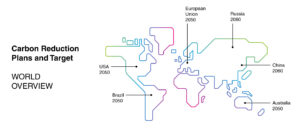Gafa 2023 has come to an end. The event saw FITT consolidate its responsibility journey, announced to the public during the 2019 edition of Gafa and restated in 2022 with the launch of its sustainability strategy, The Responsible Flow. Together with innovation, which has always been the driving force behind FITT’s business, leading to the […]
Carbon neutrality: what it is, why it is needed and how it is achieved
We hear more and more about reducing CO2eq emissions to protect the planet from the effects of climate change.
Just think of what is happening in Italy and around the world: storm Vaia, the floods in Pakistan and those of the last few hours in Emilia Romagna, the fires in California, the worst drought in 40 years in Somalia… and the list could go on.
The natural greenhouse effect has always existed, and is in itself a positive and necessary factor: if it did not exist, the average planet temperature would be around -15° instead of +18°C. In fact, the natural greenhouse effect plays a fundamental role in the growth and development of life forms.
However, over time man-made greenhouse gases, known as anthropogenic gases, have taken over. We are talking about those gases generated by the combustion of fossil fuels (coal, oil and natural gas) for energy purposes in the civil, industrial, agricultural and service sectors.
The high concentration of this type of man-made greenhouse gas causes the release of emissions that would normally occur in combustion, such as carbon dioxide, and this is what breaks the balance, leading to effects such as rising global average temperatures.
These abnormal climate occurrences are therefore the result of the anthropogenic greenhouse effect, and the winners of the 2021 Nobel Prize for Physics – Giorgio Parisi, Syukuro Manabe and Klaus Hasselmann -, as well as the Sixth Climate Report of the Intergovernmental Panel on Climate Change (IPCC), confirm the strong link between climate change and human interventions.
Halting climate change requires a drastic and rapid reduction of CO2eq emissions and other greenhouse gases released by human activities worldwide.
The Role of Countries, Institutions, Businesses and Citizens for Carbon Neutrality
Achieving carbon neutrality means achieving a balance between greenhouse gas emissions generated and reabsorbed, through a process of quantifying, reducing and compensating carbon emissions (CO2eq).
Everyone – countries, institutions, companies and individuals – is called upon to make their contribution to reducing CO2eq emissions.
Countries and institutions around the world have taken the lead by implementing long-term strategies, investing in realistic technological solutions, empowering citizens and aligning their actions in key areas such as industrial policy, finance and research, whilst also ensuring social equity for a successful energy transition that benefits society and the environment.
Direct activities that both businesses and also individual citizens can undertake to combat global warming include: saving energy, making energy production and consumption more efficient, increasing the generation and use of renewable energy sources, and following the “3 R” rule (Reduce, Reuse, Recycle).
However, direct interventions are still not enough for limiting global warming: it is also necessary to resort to compensating (offsetting) residual emissions – those that a company cannot reduce due to technical or economic limitations -, in order to reach the goal of zero net carbon dioxide emissions.
For many companies, compensating their emissions is not an obligation but a choice of social and environmental responsibility. The compensation of the carbon footprint allows companies to become part of the solution to climate change by reducing their CO2eq emissions in proportion to the pollution they generate.

How FITT strives to be part of change
For FITT, safeguarding the planet means reducing its environmental impact , limiting and compensating CO2 emissions – a priority in line with its sustainability strategy to 2030, The responsible flow.
FITT’s strategy is based on four important actions: measure, know, reduce and compensate.After reducing the environmental impact of our most innovative products, we decided to compensate the remaining CO2eq emissions from their production cycle by purchasing Gold Standard certified carbon credits from the Water is Life project in collaboration with Wami Water.
The mission of Water is Life is to bring drinking water to families living in the villages of Anketrake, Andranogadra and Ankatsaky, in Madagascar.
Even today, in some areas of the island 80% of the population has no direct access to drinking water and is forced to make long daily journeys to reach water sources in semi-desert areas.
The Water is Life project has positive consequences on three levels: health, environmental and social.
Bringing clean water to the village means providing its inhabitants with safe water, reducing the risk of infectious diseases such as diarrhoea, intestinal infections and parasitosis; it means avoiding the emission of more CO2 into the atmosphere because villagers are no longer forced to burn any kind of material to heat the water and make it suitable for drinking; it means giving children the chance to go to school, and to their mothers the chance to actively provide for their families.